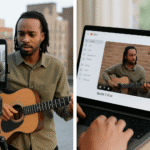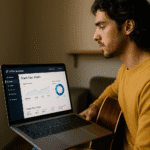When you’re an independent musician trying to get your music out there, one of the first big questions is: should you drop a single, put out an EP, or go all in with a full album?
Each format has its strengths, and the right one depends on where you are in your journey, what your goals are, and how much time and budget you’ve got. Here’s what you need to know before you hit upload.
Releasing a single
A single is a one-track release. Simple. Fast. Focused.
If you’re just getting started, releasing singles is a smart move. One song gives listeners something easy to digest, and if it hits the right note, it can help build early momentum. Singles are the most playlist-friendly format too. Playlists are still one way people discover new music.
Many artists drop a series of singles to keep their fans engaged and build anticipation ahead of an EP or album. It’s a good way to stay visible without the heavy lift of finishing a longer project.
You can self-release singles quickly on platforms including Bandcamp, SoundCloud or Audiomack (the leading music streaming service in 17 African countries). Add artwork, update your tags, and you’re done. If you’re using a distributor such as TuneCore or DistroKid, Spotify and Apple Music define a single as one to three tracks, all under 10 minutes.
Adding a music video, even something lo-fi you shot on your phone, is another way to boost a single’s impact. It gives you extra content to share and adds context for the song. You don’t need a massive budget to make it work. Check out our guide on how to shoot your own music video for free.
What’s an EP?
An EP, or Extended Play, is typically four to six tracks. It’s the halfway point between a single and an album. For independent artists, EPs are often the next logical step after a run of singles.
Why? You get more space to show who you are, musically, without the pressure of putting together a full album. It’s also cheaper to produce than a full-length record. One artwork, one upload, and one mastering session can cover multiple songs.
There are also practical advantages. Digital stores such as Beatport and iTunes count every track sold on an EP toward your overall release performance. That means better chart potential. If you’re aiming to get featured or break into sales charts, an EP gives you a better shot than a single.
Just keep in mind that the more tracks you include, the more they should feel like they belong together. Whether it’s a shared vibe, sound, or story; a little cohesion goes a long way.
Releasing an album
Releasing a full album is a big step. It’s a major statement. It says you’ve got something to say and enough solid material to back it up.
An album usually runs at least eight tracks, sometimes up to 70 minutes. It’s traditionally the ultimate artistic format, showing consistency and vision. But it’s also the most time-consuming and expensive to create. Studio time, mixing, mastering, and promotion all add up. And these days, long-form releases don’t always get the attention they deserve.
Most fans discover new music through singles and playlists. So even if you pour your soul into a 12-track album, there’s a good chance people will only hear one or two songs and these are typically the tracks that are playlisted or picked up by the algorithm.
If you’ve got an engaged fanbase and a clear concept, an album can still hit hard. But if you’re still growing your audience, it might be better to hold off.
So, which should you release?
- Start with singles. They’re the easiest way to test the waters, get feedback, and stay in the conversation.
- Use EPs to take the next step. Show your range, explore themes, and build credibility.
- Save albums for when you’re ready. If you’ve built up an audience, have a bigger story to tell, or want to mark a milestone, an album makes sense.
Many record labels are looking for long-term plans, not one-off drops. Releasing regular singles can help you grow your fanbase steadily and prove you’re in it for the long game.
Whatever path you choose, make it count. Quality matters more than quantity. And with every release, you’re building a body of work that tells your story.
Don’t get stuck waiting for the “perfect” time to release. There’s no perfect. There’s just now. Start small, stay consistent, and keep learning as you go.




